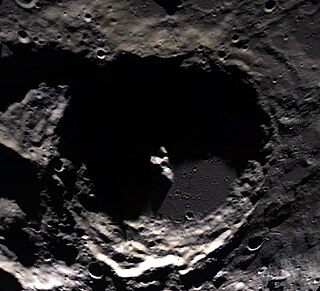
Amundsen is a large lunar impact crater located near the south pole of the Moon, named after the Norwegian explorer Roald Amundsen. It lies along the southern lunar limb, and so is viewed from the side by an observer on the Earth. To the northwest is the crater Scott, a formation of similar dimensions that is named for another Antarctic explorer. Nobile is attached to the western rim.

Hermite is a lunar impact crater located along the northern lunar limb, close to the north pole of the Moon. Named for Charles Hermite, the crater was formed roughly 3.91 billion years ago.

Shackleton is an impact crater that lies at the lunar south pole. The peaks along the crater's rim are exposed to almost continual sunlight, while the interior is perpetually in shadow. The low-temperature interior of this crater functions as a cold trap that may capture and freeze volatiles shed during comet impacts on the Moon. Measurements by the Lunar Prospector spacecraft showed higher than normal amounts of hydrogen within the crater, which may indicate the presence of water ice. The crater is named after Antarctic explorer Ernest Shackleton.

Cabeus is a lunar impact crater that is located about 100 km (62 mi) from the south pole of the Moon. At this location the crater is seen obliquely from Earth, and it is almost perpetually in deep shadow due to lack of sunlight. Hence, not much detail can be seen of this crater, even from orbit. Through a telescope, this crater appears near the southern limb of the Moon, to the west of the crater Malapert and to the south-southwest of Newton.

Shoemaker is a lunar impact crater located near the southern pole of the Moon, within half a crater diameter of Shackleton.

Faustini is a lunar impact crater that lies near the south pole of the Moon. It is located nearly due south of the much larger crater Amundsen, and is almost attached to Shoemaker to the southwest. About one crater diameter due south is the smaller crater Shackleton at the south pole. A small crater is attached to the eastern rim of Faustini.
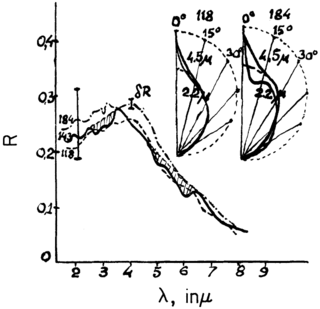
Lunar water is water that is present on the Moon. Diffuse water molecules in low concentrations can persist at the Moon's sunlit surface, as discovered by the SOFIA observatory in 2020. Gradually, water vapor is decomposed by sunlight, leaving hydrogen and oxygen lost to outer space. Scientists have found water ice in the cold, permanently shadowed craters at the Moon's poles. Water molecules are also present in the extremely thin lunar atmosphere.

Chao Meng-Fu is a 167 km (104 mi) diameter crater on Mercury named after the Chinese painter and calligrapher Zhao Mengfu (1254–1322). Due to its location near Mercury's south pole and the planet's small axial tilt, an estimated 40% of the crater lies in permanent shadow. This combined with bright radar echoes from the location of the crater leads scientists to suspect that it may shelter large quantities of ice protected against sublimation into the near-vacuum by the constant −171 °C (−276 °F) temperatures.

The geology of Mercury is the scientific study of the surface, crust, and interior of the planet Mercury. It emphasizes the composition, structure, history, and physical processes that shape the planet. It is analogous to the field of terrestrial geology. In planetary science, the term geology is used in its broadest sense to mean the study of the solid parts of planets and moons. The term incorporates aspects of geophysics, geochemistry, mineralogy, geodesy, and cartography.
A cold trap is a concept in planetary sciences that describes an area cold enough to freeze (trap) volatiles. Cold-traps can exist on the surfaces of airless bodies or in the upper layers of an adiabatic atmosphere. On airless bodies, the ices trapped inside cold-traps can potentially remain there for geologic time periods, allowing us a glimpse into the primordial solar system. In adiabatic atmospheres, cold-traps prevent volatiles from escaping the atmosphere into space.
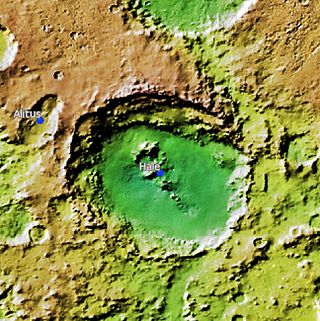
Hale is a 150 km × 125 km crater at 35.7°S, 323.4°E on Mars, just north of Argyre basin. The crater is in the Argyre quadrangle. It was named after American astronomer George Ellery Hale.
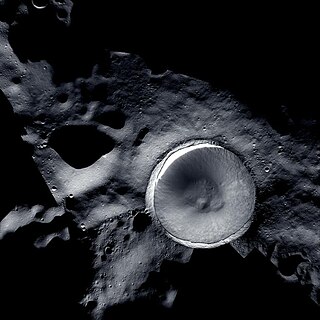
The lunar south pole is the southernmost point on the Moon. It is of interest to scientists because of the occurrence of water ice in permanently shadowed areas around it. The lunar south pole region features craters that are unique in that the near-constant sunlight does not reach their interior. Such craters are cold traps that contain a fossil record of hydrogen, water ice, and other volatiles dating from the early Solar System. In contrast, the lunar north pole region exhibits a much lower quantity of similarly sheltered craters.

The Mare Acidalium quadrangle is one of a series of 30 quadrangle maps of Mars used by the United States Geological Survey (USGS) Astrogeology Research Program. The quadrangle is located in the northeastern portion of Mars’ western hemisphere and covers 300° to 360° east longitude and 30° to 65° north latitude. The quadrangle uses a Lambert conformal conic projection at a nominal scale of 1:5,000,000 (1:5M). The Mare Acidalium quadrangle is also referred to as MC-4.

Despréz is a crater on Mercury with a diameter of 47.05 kilometers. Its name was adopted by the International Astronomical Union (IAU) in 1979. Despréz is named for the French composer Josquin des Prez, who lived from 1440 to 1521.
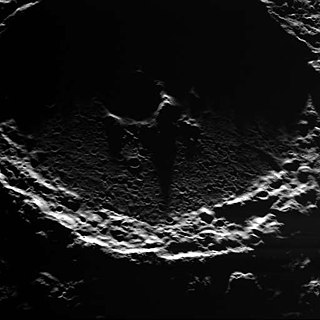
Prokofiev is a crater near the north pole of the planet Mercury, named after the Russian composer Sergei Prokofiev. Data from the MESSENGER spacecraft indicates that it contains water ice and organic compounds. Although other craters in Mercury's north polar region are also believed to contain ice, Prokofiev is the largest of them, with probable surface ice along the southern crater floor that is in perpetual darkness.

A permanently shadowed crater is a depression on a body in the Solar System within which lies a point that is always in darkness.
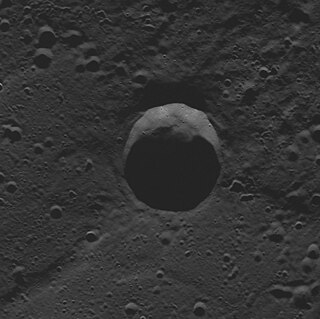
Carolan is a crater on Mercury. Its name was suggested by an Irishman, Fergal Donnelly, and two Americans, Joseph Brusseau and Deane Morrison, in a naming contest which was eventually adopted by the International Astronomical Union (IAU) on 2015. Carolan is named for the Irish composer and performer Turlough O'Carolan, who lived from 1670 to 1738 C.E. The craters Kulthum, Enheduanna, Karsh, and Rivera were also named as part of the contest.

Vonnegut is a crater on Mercury, near the north pole. It was named by the IAU in 2017 after the American author Kurt Vonnegut. Part of Vonnegut's 1959 novel The Sirens of Titan takes place on Mercury. The crater was referred to as e5 in scientific literature prior to naming.

Yamada is a crater on Mercury. It has a diameter of 17.1 kilometres. Its name was adopted by the International Astronomical Union (IAU) on November 4, 2015. Yamada is named for the Japanese composer and conductor Kosaku Yamada. The crater was referred to as n5 in scientific literature prior to naming.
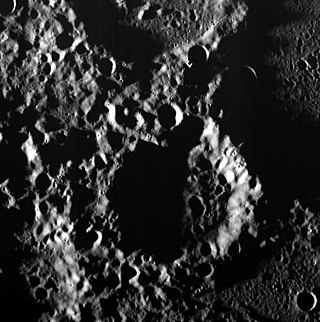
Josetsu is a crater on Mercury, located near the north pole. Its name was adopted by the International Astronomical Union (IAU) in 2019. It is named for the Japanese painter Taikō Josetsu. The crater was referred to as o7 in scientific literature prior to naming.
















